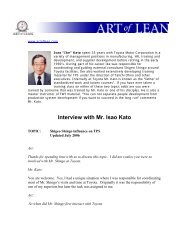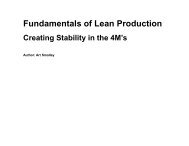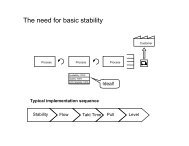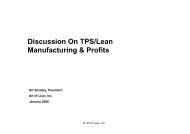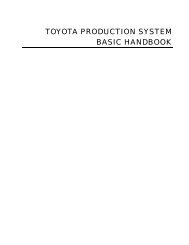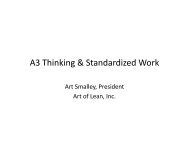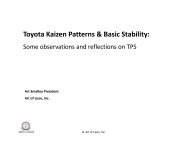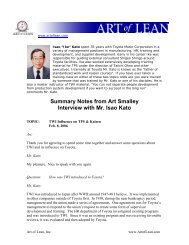Kamigo Engine Plant Tour Review Toyota Motor ... - Art of Lean
Kamigo Engine Plant Tour Review Toyota Motor ... - Art of Lean
Kamigo Engine Plant Tour Review Toyota Motor ... - Art of Lean
Create successful ePaper yourself
Turn your PDF publications into a flip-book with our unique Google optimized e-Paper software.
cutting tool removing metal in machining so you need to learn more about the machines,<br />
materials, tooling, and the mechanical properties <strong>of</strong> chip removal.<br />
<strong>Art</strong>:<br />
So how are you training people to make improvements in machining areas?<br />
It is still the same way that you had to learn via OJT. There is no easy shortcut for this<br />
area. In some cases like yours we have people initially work in the spare parts machine<br />
shop to learn the basics <strong>of</strong> turning, milling, and grinding for example.<br />
Then they are assigned some basic quality and downtime problems to be solved in detail.<br />
No value stream mapping is used but they have to learn the 30 processes that make up the<br />
crankshaft line for example one by one. We have people sketch the machining process,<br />
identify the datum point, study the clamp mechanism, learn the type <strong>of</strong> cutting tool, and<br />
how the chip is removed for example. It is lot <strong>of</strong> attention to detail and it requires<br />
“getting your hands dirty” as the old saying goes.<br />
There is lots <strong>of</strong> technical documentation involved and process capability issues as well.<br />
We still think it takes 5-7 years to make a young engineer learn all the basic aspects <strong>of</strong><br />
the job in machining and become pr<strong>of</strong>icient in kaizen.<br />
<strong>Art</strong>:<br />
What key points <strong>of</strong> advice for anyone wanting to improve using TPS style activities in this<br />
sort <strong>of</strong> environment?<br />
Number one it is a lot <strong>of</strong> hard work so don’t kid yourself into thinking otherwise. Mr.<br />
Ohno started TPS in the machine shops <strong>of</strong> <strong>Toyota</strong> and this is where the real TPS pillars <strong>of</strong><br />
JIT and Jidoka concepts come from. It did not happen over night and it was a long battle<br />
that involved improvements in processes, tooling, maintenance, etc. for example.<br />
Second don’t confuse the “objective” versus the “method”. I keep seeing or reading<br />
these comments about flow, standardized work, pull, or visual control etc. being the<br />
“goal” <strong>of</strong> different companies production system or improvement efforts. Those items<br />
are merely techniques and they will get you no where in the long run if you only focus on<br />
applying them. The real objective in TPS is to obtain a pr<strong>of</strong>it and satisfy the customer.<br />
In manufacturing our small role is to build in the highest possible quality, reduce cost,<br />
and deliver in the shortest time possible. Everything else under that is just a method<br />
whether it be kanban, or standardized work, or level production for example. The<br />
methods and tools will change over time. Don’t waste time copying <strong>Toyota</strong>’s tools.<br />
Figure out what your own biggest problems are and solve those.<br />
Third the real emphasis in machine intensive shops is building in quality and separation<br />
<strong>of</strong> man from machine. Jidoka is equal if not more important that JIT in machining. You<br />
can fix the flow fairly easily if you have great processes. If you just have JIT and poor



